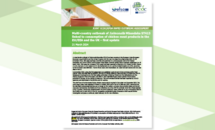Threat assessment brief: Oropouche virus disease cases imported to the European Union
In June and July 2024, 19 imported cases of Oropouche virus disease were reported for the first time in EU countries: Spain (12), Italy (5), and Germany (2).
Epidemiological situation
In June and July 2024, 19 imported cases of Oropouche virus disease were reported for the first time in EU countries: Spain (12), Italy (5), and Germany (2). Eighteen of the cases had a travel history to Cuba and one to Brazil. Oropouche virus disease is a zoonotic disease caused by the Oropouche virus (OROV). To date, outbreaks of OROV disease have been reported in several countries across South America, Central America and the Caribbean. During 2024, outbreaks have been reported in Brazil, Bolivia, Colombia, Peru, and more recently in Cuba. Oropouche virus is mainly transmitted to humans as a result of being bitten by infected midges, however some mosquitoes species can also spread the virus. The principal vector (Culicoides paraensis midge) is widely distributed across the Americas, but absent in Europe. To date, there has been a lack of evidence as to whether European midges or mosquitoes could transmit the virus. Oropouche virus disease can manifest as an acute febrile illness with headache, nausea, vomiting, muscle and joint pains, and occasionally more severe symptoms. The prognosis for recovery is good and fatal outcomes are extremely rare. There are no vaccines to prevent or specific medication to treat OROV disease. Direct, horizontal, human-to-human transmission of the virus has not been documented so far. Recently, the Brazilian Ministry of Health reported six possible cases of OROV disease being passed from mother-to-child during pregnancy. The potential risk during pregnancy and fetopathic effects of OROV infection are still under investigation and have not been confirmed.
Risk assessment
The likelihood of infection for EU/EEA citizens travelling to, or residing in epidemic areas in South and Central America is currently assessed as moderate. The likelihood of infection increases if travellers visit the more-affected municipalities of the northern states of Brazil and/or the Amazon region, and/or if personal protection measures are not taken. Given the good prognosis for recovery, the impact is assessed as low. The risk of infection for EU/EEA citizens travelling to OROV-epidemic countries in the Americas is therefore assessed as moderate.
Recent data indicate that OROV infection in pregnant women may lead to miscarriage, abortion and/or developmental problems, and deformities of the foetus. The impact of OROV infection for pregnant women, foetuses and newborns could therefore be higher than for the general population, although this is still under investigation.
The likelihood of human exposure to OROV in the EU/EEA is considered very low, despite the possible importation of further OROV disease cases, as the competent vectors commonly described in the Americas are absent from continental Europe, and to date, no secondary transmission has ever been reported. Therefore, the risk of locally-acquired OROV disease in the EU/EEA is low.
Recommendations
Personal protective measures to reduce the risk of bites in epidemic areas include the use of repellent in accordance with the instructions indicated on the product label, wearing long-sleeved shirts and long trousers and using insecticide-treated fine mesh mosquito bed nets when resting. These measures are essential to provide protection against bites in rooms that are not adequately screened (with fine-mesh screens on doors and windows) or air-conditioned, and during outdoor activities.
Symptoms of OROV disease can be similar to other arboviral infections, such as dengue, chikungunya or Zika. The early detection of travel-associated cases can be enhanced by an increasing awareness among health professionals of travellers returning from areas with active OROV transmission, and adequate laboratory diagnostic capability, recently supported by the EVD-LabNet for laboratory network members in the EU/EEA. Laboratory testing for OROV should be performed when other tests for diseases of common aetiology (e.g. dengue, chikungunya or Zika) are negative. In addition, travel medicine clinics should inform travellers to epidemic areas of the risks related to the disease and protective measures that can reduce the likelihood of infection. In addition, public health authorities should report new cases of OROV infection through Epipulse to enable a continuous assessment of the situation.
Due to the potentially high impact of congenital OROV infection, pregnant women planning to travel to epidemic countries where transmission is ongoing or has been reported should be provided with comprehensive information on the potential risk associated with OROV infection and prevention strategies. Areas affected by OROV are also classified as countries and territories with current or previous Zika virus (ZIKV) transmission, and travel advice for pregnant women related to ZIKV can also adequately address the potential risk associated with Oropouche virus disease.
Download





